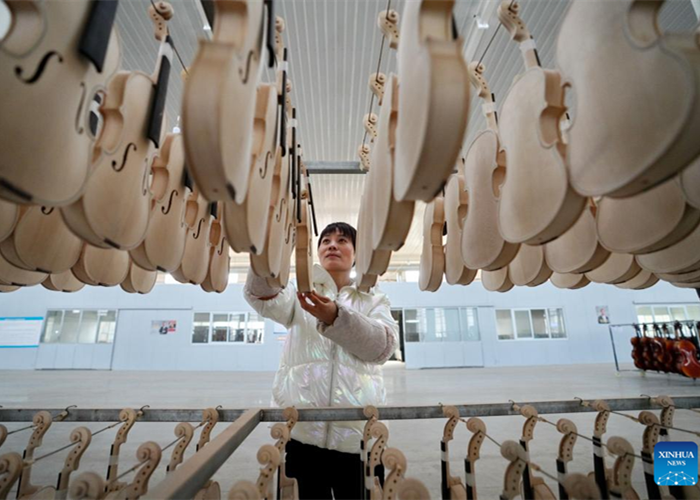40 Years on: Development of Women and Children in Shenzhen, S China
Shenzhen, in South China's Guangdong Province, celebrated its 40th anniversary of the establishment of the Shenzhen Special Economic Zone (SEZ) on August 26. In just over 40 years, Shenzhen has witnessed a miraculous rise, turning from a small fishing village into a global economic powerhouse.
Shenzhen has developed into a metropolis with a permanent population of 13 million people. Its GDP hit 2.69 trillion yuan (US $388.89 billion) in 2019, after rising at an annual growth rate of 21.6 percent between 1979 and 2019.
Its development has offered the world a glimpse of the vitality of China's progress and its commitment to reform and opening-up.
Over the past 40 years, Shenzhen has also been promoting the development of women and children, improving the quality of their lives and strengthening women's economic and political participation.
In particular, Shenzhen is among the first cities in mainland China to introduce local laws and regulations on gender equality. It took the lead in establishing a mechanism of high-standard gender equality evaluation and a scientific, gender-focused social statistics system, as well as promoting the construction of a child-friendly city.
Development Environment for Women, Children Keeps Improving
In 2012, the Shenzhen Women's Federation issued the Regulations on Promotion of Gender Equality in SEZ, which clarified the meaning of "gender equality" from a legal perspective. It set up a special working institution, alongside a series of innovative systems looking at gender statistics, gender analysis, gender assessment, gender auditing and anti-gender discrimination in employment, filling a gap in local gender equality legislation on the Chinese mainland.
Due to its exemplary role in boosting women's development, the establishment of the regulations was listed as the first of the Top 10 National Rights Protection Events in 2012 by the All-China Women's Federation. The Shenzhen Women's Federation was granted the Women's Development Contribution Award by UN Women in 2013.
In March 2016, Shenzhen established a high-level gender equality evaluation mechanism led by the Shenzhen Municipal People's Congress, which integrated the concept of gender equality into the formulation, implementation and supervision of laws and regulations. The gender equality evaluation committee has since assessed 106 regulations, policies and normative documents and put forward 169 suggestions for revisions, 70 percent of which have been adopted.
The city has also paid special attention to children in recent years. With the aim of building the first child-friendly city in China, it follows a "child first" principle, and focuses on building an urban environment suitable for children's healthy growth.
By the end of 2019, there were 69 child-friendly pilot communities, streets and parks, 17 schools, 11 libraries, 13 hospitals, 21 child-friendly practice bases and 686 women and children's homes across the city. By the end of this July, 845 mother-and-baby rooms had been established in public places.
It has built more than 1,000 parks, and upgraded facilities with improved space for children's activities and nature education. "Slow street lanes" are currently undergoing renovation for the convenience of children when they travel around the city.
Shenzhen's explorations and practices won it the first Innovation Award of Chinese Urban Governance. And, due to the city's influence, child-friendly practices have been extended to Hong Kong and Macao special administrative regions, forming a trend of promoting the development of women and children in the Guangdong-Hong Kong-Macao Greater Bay Area.
Female Talents Emerge from All Walks of Life
The Shenzhen Female Culture Salon in 2020, with the theme of Female Power in 40-Year Development of Shenzhen, kicked off on August 13 as a special gift for the 40th anniversary of the founding of SEZ.
The event invited women representatives from all walks of life to tell their stories of struggles and experiences in the city, including a leading entrepreneur in financial security sector, a frontline medical worker fighting against COVID-19, a recipient of the honorary title of the Shenzhen Municipal Most Beautiful Family and a social worker who doesn't let go of her dream.
Over the past four decades, there has been a significant increase in female entrepreneurs and scientific and technical workers. In 2019, women accounted for 35.93 percent of senior professional and technical personnel and 41.13 percent of the members of the workers' congresses.
Every leading group of municipal and district Party committees employs female officials, and the proportion of female secretaries in community Party committees and female directors of neighborhood committees in Shenzhen ranks highly compared with other cities in Guangdong Province.
Women are taking a more active part in building a civilized city. Shenzhen held the country's first women's marathon and has set up more than 1,000 women volunteers' teams, attracting 740,000 women volunteers. The city has a large number of recipients of the titles of the March 8th Red-banner Holder and the March 8th Red-banner Collective at all levels, showcasing the role of women in "helping to hold up half the sky."
"Born in different generations and coming from all over the world, Shenzhen women share the same characteristics: independent, intelligent, fashionable, confident, inclusive and creative," said Ma Hong, President of Shenzhen Women's Federation.
"Over the past 40 years, women have upheld a forceful spirit and worked hard in the SEZ. They forge ahead with the city and follow the pace of the times, making great contributions to Shenzhen's reform, development and stability," she noted.
(Source: China Women's News/Translated and edited by Women of China)
Please understand that womenofchina.cn,a non-profit, information-communication website, cannot reach every writer before using articles and images. For copyright issues, please contact us by emailing: website@womenofchina.cn. The articles published and opinions expressed on this website represent the opinions of writers and are not necessarily shared by womenofchina.cn.








 WeChat
WeChat Weibo
Weibo 京公网安备 11010102004314号
京公网安备 11010102004314号